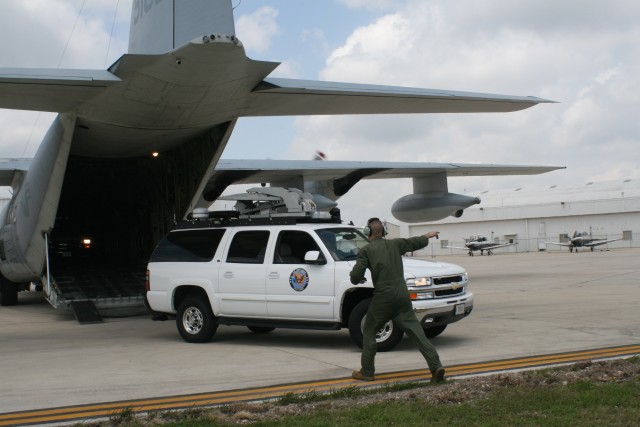AUSTIN, Texas (Army News Service, June 19, 2007) - First responders and civil-support-operations personnel from the Department of Defense, Federal Emergency Management Agency and state of Texas trained for a hurricane disaster in Austin during the Texas Hurricane Exercise June 4-7.
The event allowed the state and its federal partners to evaluate Brownsville and Houston-Galveston evacuation plans as a fictional Category 4 "Hurricane Debbie" approached Texas, while U.S. Army North's Region VI Defense Coordinating Element tested its civil-support operations.
Region VI Defense Coordinating Officer Col. Laverm Young commands the six-person Region VI DCE, which focuses on the states of Texas, Louisiana, Arkansas, New Mexico and Oklahoma.
He said the Texas exercise was an opportunity for "tremendous relationship building" and the first time that all federal and state partners were in one location at one time using one common timeline.
"All the senior leaders who would be involved in a disaster were there - the policy makers, the doctrine developers and the operators, all in the same room," he said. "It struck me how passionate they all are about saving lives, reducing suffering and helping people's lives return to normal."
The element is one of 10 that serve as Department of Defense first responders during a disaster in the United States During deployments or exercises, it's augmented by Army North experts in fields such as aviation, logistics, medical planning and engineering, as well as emergency preparedness liaison officers - members of the reserve components of all services - who are experts on their state or region's response plans.
The exercise was an opportunity for the element to practice integrating their augmentees, deploying to forward locations and processing requests for assistance.
"As individuals, we have our own strengths and weaknesses but as a whole we became a highly functioning team," DCE Operations Officer Maj. Cole Bricker said. "That's why we exercise like this - because we need to learn and grow and practice."
Joshua Barnes, special assistant to the Federal Coordinating Officer, said that states are equipped to handle most emergencies, but that a disaster often requires a more extensive response, including federal assistance.
"Seeing more DOD operations and processes helps FEMA learn the types of resources that are available so we can tailor our requests for assistance appropriately," he said. "We are also able to identify possible needs of the state by looking at what they are doing, so we can plan to provide the additional capabilities the state may need."
Mr. Barnes said that states usually request additional medical support, commodities like water and ice, and air and ground transportation.
"For DOD, this usually translates into providing transportation assets to deliver water and ice to distribution points, providing additional helicopter transportation or search-and-rescue capabilities - things the states can do, but DOD can help them expand their operations during a disaster," Mr. Barnes said.
According to Maj. Bricker, even the exercise controllers said they learned from the exercise and will use the experience during future exercises within Army North.
Col. Young said he's confident his team is ready to coordinate support if needed during hurricane season.
"Relationships among DOD, FEMA and the states have improved since 9/11," he said. "And FEMA's leaning forward now more than ever to provide that presence with the state before a disaster. We keep ourselves packed and ready to go, because we're DOD's first responders. That's why I love this job. We're here to help Americans, and it's our way of giving back."
Patti Bielling is a public affairs officer with U.S. Army North.




Social Sharing